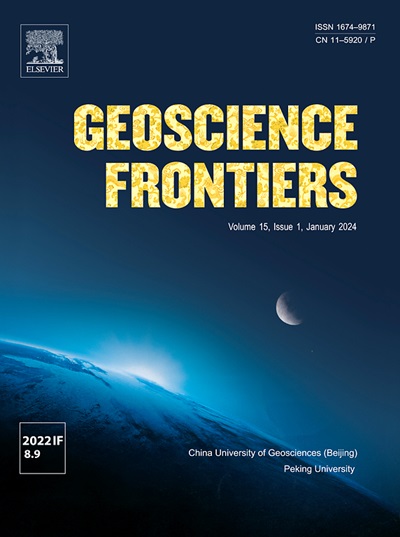scoc -2钻孔下古生代沉积岩碎屑锆石年代学研究
IF 8.9
1区 地球科学
Q1 GEOSCIENCES, MULTIDISCIPLINARY
引用次数: 0
摘要
从scoc -2陆相钻探项目中恢复的岩心中恢复了约1200 m厚的寒武-奥陶系沉积序列,报道了碎屑锆石年代学。在标志着次寒武纪准平原的风化层之上,下至中寒武纪的演替由砾岩、砂岩和页岩组成,由重力流覆盖,向上细化至明矾页岩组。寒武纪(1)序列碎屑锆石年代学初步结果表明,原生盖层基底剖面主要以古元古代晚期-中元古代早期碎屑颗粒为特征。序列中段以晚古元古代碎屑岩为主,少量中元古代和太古代碎屑岩输入。下寒武统(?)演替的上部以太古宙至寒武纪的碎屑岩为特征。下寒武统上段最大沉积年龄为530.5±4 Ma。明矾页岩组以上的下奥陶统2个样品的年龄主要为中元古代至新元古代早期(1.5 ~ 0.9 Ga)。下段原生下寒武统被动边缘演替以局部碎屑岩为主,这些碎屑岩全部来自于seconorwegian造山带东段,其中包括COSC-2研究的基底。上剖面物源向跨斯堪地那维亚火成岩带和西芬尼安造山带转移,最年轻的序列中有明显的新元古代—寒武系活动边缘碎屑输入。奥陶纪(?)演替以种群为特征,可能来自于斯科诺威造山带,并有少量的克拉通贡献。对整个波罗的海碎屑锆石数据集的统计分析表明,南波罗的海/桑多米里亚弧,而不是提曼尼亚造山带,是整个古大陆碎屑物质的重要来源。提曼尼亚造山带颗粒的影响仅限于斯堪的纳维亚半岛的最北端,而桑多米里亚碎屑则在中寒武纪至下寒武纪到达斯堪的纳维亚半岛中部,并在下奥陶统期间普遍存在于斯堪的纳维亚半岛南部。本文章由计算机程序翻译,如有差异,请以英文原文为准。

Detrital zircon geochronology of lower Palaeozoic sedimentary rocks from the COSC-2 borehole, Scandinavian Caledonides
Detrital zircon geochronology is reported from the c. 1200 m thick Cambro-Ordovician sedimentary succession recovered in core from the COSC-2 continental drilling project in the Scandinavian Caledonides. Above a regolith marking the sub-Cambrian peneplain, a lower to middle Cambrian(?) succession comprises conglomerate, sandstone and shale overlain by gravity flows fining upwards into the Alum Shale Formation. First results of detrital zircon geochronology from the Cambrian(?) succession show that the basal section of the autochthonous cover is characterized by mainly late Paleoproterozoic – early Mesoproterozoic detrital grains. The middle part of the succession is dominated by late Paleoproterozoic detritus with minor Mesoproterozoic and Archean input. The upper part of lower Cambrian(?) succession is characterized by Archean to Cambrian detritus. The maximum depositional age is calculated to 530.5 ± 4 Ma for the upper part of the lower Cambrian succession. Two samples from the Lower Ordovician(?) succession above the Alum Shale Formation show predominantly Mesoproterozoic to early Neoproterozoic (1.5–0.9 Ga) ages.
The autochthonous lower Cambrian(?) passive margin succession in the lower section is dominated by local detritus, sourced exclusively from the Eastern Segment of the Sveconorwegian Orogen, which includes the basement studied in COSC-2. Up-section, the provenance shifts towards the Transscandinavian Igneous Belt and Svecofennian Orogen sources, with the youngest part of the succession showing a notable input of Neoproterozoic –Cambrian active margin detritus. The Ordovician(?) succession is characterized by populations, likely derived from the Sveconorwegian Orogen, and a minor cratonic contribution.
Statistical analysis of detrital zircon datasets across Baltica suggests that the Southern Baltica/Sandomirian Arc, rather than the Timanian Orogen, was a significant source of detrital material across the paleocontinent. The influence of Timanian Orogen grains is limited to northernmost Scandinavia, whereas Sandomirian detritus reached central Scandinavia in the lower to middle Cambrian and remained prevalent in southern Scandinavia into the Lower Ordovician.
求助全文
通过发布文献求助,成功后即可免费获取论文全文。
去求助
来源期刊

Geoscience frontiers
Earth and Planetary Sciences-General Earth and Planetary Sciences
CiteScore
17.80
自引率
3.40%
发文量
147
审稿时长
35 days
期刊介绍:
Geoscience Frontiers (GSF) is the Journal of China University of Geosciences (Beijing) and Peking University. It publishes peer-reviewed research articles and reviews in interdisciplinary fields of Earth and Planetary Sciences. GSF covers various research areas including petrology and geochemistry, lithospheric architecture and mantle dynamics, global tectonics, economic geology and fuel exploration, geophysics, stratigraphy and paleontology, environmental and engineering geology, astrogeology, and the nexus of resources-energy-emissions-climate under Sustainable Development Goals. The journal aims to bridge innovative, provocative, and challenging concepts and models in these fields, providing insights on correlations and evolution.
 求助内容:
求助内容: 应助结果提醒方式:
应助结果提醒方式:


